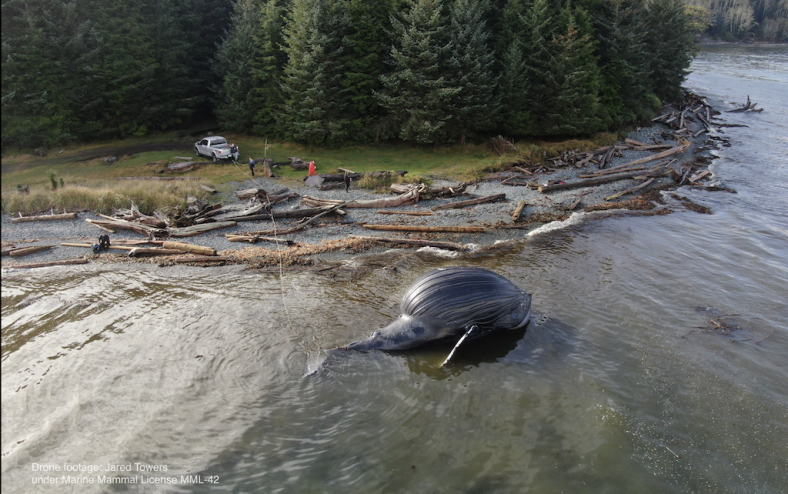That bloated, giant blue balloon on the beach?
Yeah, that’s actually a whale.
More specifically, that’s Spike.
A young female humpback, she was affectionately named by researchers for the cute dinosaur-shaped birthmark on her side.
As should be pretty obvious, she’s no longer swimming around the ocean as she should be. Instead, she’s on a beach on the north side of Malcolm Island.
And we don’t know why.
“It’s absolutely gutting,” said Jackie Hildering, otherwise known as the “Marine Detective,” to the National Observer.
“We get to feel the depths of emotion that result from knowing these whales as individuals.”
Spike was healthy and far too young to die of natural causes. That leaves researchers stumped over why she’s lying swollen on the beach
“We do not know the cause of death. Considering Spike was a young female and that there are no apparent external injuries, it will not be a surprise if it is found that she died from blunt force trauma from being hit by a boat,” said the Marine Education & Research Society.
They’ll be racing to find out her cause of death from here on out. One little-known fact about whales, once they die they’re a ticking time bomb.

Spike’s body doesn’t look like a balloon for no reason. It’s inflated as a result of gases building up from decay.
When those gases reach a point of pressure that her body can’t take anymore, she’ll explode.
Yikes.
Hopefully, she holds till Wednesday. That’s when a necropsy with MERS members and Fisheries and Oceans Canada is scheduled to help find her cause of death and other valuable information about Spike’s life.
“It offers us a rare opportunity to learn from the whale, again because most dead whales sink,” said Hildering to CHEK News.
It’s still safe to see Spike’s body from a distance if you live in the area.
Researchers have chosen to make it viewable to help spread awareness of the dangers unsafe boating can pose to wildlife.
Hildering says humpbacks, which were almost hunted to extinction 50 years ago, have made a remarkable comeback. For some reason, they appear to be moving closer to shore.
Scientists aren’t sure why this is. They say climate change or prey could be possible reasons. Regardless of the reason, their migrations are making boating incidents all the more common.
Boaters should always be aware of the simple steps to keep animals (especially those as big as a hunchback) safe while they’re out on the water.
If you spot something, power down your propeller and turn off your sonar, so the whale isn’t attracted any closer.
If you’re local and you’d like to go pay your respects before Spike’s gone forever, you can head to north Malcolm Island to “Sam’s Place.”
For more info on how to protect both yourself and our whales, you can head to www.SeeABlowGoSlow.org.
If you’re out on the water and see something, say something. Call the DFO Incident Reporting Line at 1-800-465-4336.
Rest in peace, Spike.









